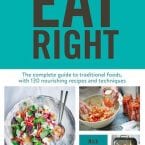Description
OF LATE, HAMBURGERS HAVE BEEN REHABILITATED AS A GOURMET TREAT. This is a good thing. For too long a hamburger has been a popular convenience food for all the wrong reasons. Now there are restaurants, cafés, and even specialty fast-food chains selling burgers made with high-quality ingredients, such as aged beef from traditional breeds, wild game meat, freshly made buns with simple ingredients, as well as an ever-changing selection of nutrient-rich toppings and fillings, such as raw milk cheeses and fermented pickles. Making your own super flavorful and nutrient-dense burgers is extremely simple. All you need is your friendly butcher with his trusted source of pastured (grass-fed) beef that has been (dry) aged, and a willingness to grind beef for you from the richly marbled cuts of meat such as chuck and shin. You don’t want lean ground beef here—in fact, not ever. To pimp up the nutrients, have your butcher add some beef heart to your mixture. Unlike other organ meat, beef heart is, of course, muscle meat. It is packed with rich goodness, including enhanced levels of protein, iron, selenium, phosphorus, zinc, CoQ10, folate, thiamine, and other B vitamins. CoQ10? This is a coenzyme, somewhat similar to a vitamin. It is held to give considerable health benefits but there is no clear consensus or understanding as to its precise efficacy. What is certain is that it plays a key part in our metabolic processes, and that given that our food regimes are so often nutrient, trace element, and mineral deficient, it is a boon to boost our wellness with such precious natural supplements. That’s a good way to consider organ meats: as natural supplements. The trick is how to sneak them into everyday foods; adding about 10 to 20 percent beef heart to all your ground beef is a perfect solution. How to cook hamburgers? It’s all about balancing health with taste. What seems clear is that flame grilling and barbecuing can be a rather brutal way to cook foods. Depending on the fuel you use, there may be toxins in the smoke, and if any flames come in direct contact with the meat, there is evidence that carcinogens are created. Use a barbecue sparingly, as a treat, with natural charcoal as a fuel, and make sure that you don’t flame the foods. It’s okay, however, to cook your vegetables on the barbecue this way. Better to cook burgers, like your steaks, in a cast-iron frying pan, and if you want to mimic the grill, then use a cast-iron griddle or ridged pan.
Ingredients
- 1 ¼ pounds freshly ground beef from aged chuck or shin cuts that come from pastured traditional beef breeds (with some (10 to 20 percent) beef heart (optional))
- 2 or 3 garlic cloves (smashed and finely chopped)
- Sea salt and freshly ground black pepper
- Extra virgin olive oil or tallow
- 4 burger buns (brioche style, freshly made, by an artisan baker)
- Butter (preferably raw)
Condiments—select from
- Sliced Gruyère or aged Cheddar cheese made with raw milk
- Kimchi
- Sauerkraut
- Pickled or lacto-fermented gherkins
- Fresh arugula or other strongly flavored green (like watercress or radicchio)
- Slightly fermented tomato sauce (and homemade mayonnaise)
- Onion rings or sliced onions sautéed in ghee until lightly caramelized
Instructions
- Mix the garlic into the beef, along with a couple of big pinches of salt and some freshly ground black pepper.
- Form into 4 patties, slightly smaller in diameter than the buns. Or, if your buns are small, make the burgers no more than 1-inch thick or they won’t cook through properly.
- Smear the burgers with a little olive oil or tallow to help prevent them from sticking in the pan. Slice and butter the buns, and prepare any condiments, such as the onions.
- Heat your frying pan over medium-high heat. When it is about to smoke, lower the heat to medium and cook the burgers, two at a time. Press them down lightly onto the pan, and then leave alone for 3-5 minutes each side, depending on their thickness. You’re looking for a medium–rare finish; you can’t really tell by pressing the burger, so if in doubt, cook for less time. You can always return the burger to the pan.
- Place another frying pan, preferably a grill pan, over medium heat, and once you’ve flipped the burgers put the buns butter–side down onto the frying pan and remove when they are lightly browned.
- Once you’ve flipped the burgers, press them down lightly again and cook for another 3 to 5 minutes. If you want a cheeseburger, now is the time to lay a slice of cheese on top.
- Serve immediately with an array of nutrient-dense condiments.
